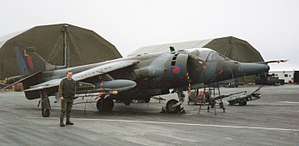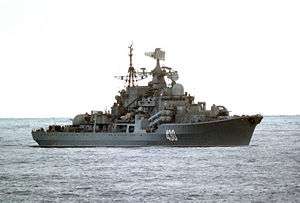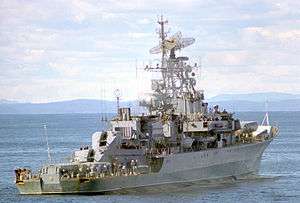Northern Wedding
Northern Wedding was a NATO Cold War naval military exercise, designed to test NATO's ability to rearm and resupply Europe during times of war. In 1978, it was described as being 'conducted every four years', but by the mid 1980s, Exercise Ocean Safari was being run in odd-numbered years, 'every other year, alternating with Northern Wedding.'[1]
Exercises
Soviet intelligence ship Linza observing NATO ships during Exercise Northern Wedding 86

East german intelligence ship Jasmund
- 1970 - involved Royal Navy aircraft carriers[2] and the Dutch Dolfijn-class submarine HNLMS Dolfijn.[3]
- 1972 - involved Royal Navy aircraft carriers.[4]
- 1974 - involved Avro Vulcan aircraft of RAF Strike Command as part of the opposing force.[5]
- 1978 September. The exercise was conducted by 40,000 men, 22 submarines, and 800 aircraft from nine countries.[6] Two amphibious landing took place, one in the Shetland Islands and a second in Denmark.[7] After a brief stop in Palma (24–28 August 1978), USS Forrestal (CV-59) left the Mediterranean en route to the Atlantic and the North and Norwegian Seas to take part in the huge NATO exercise Northern Wedding (4–18 September). It exercised allied abilities to reinforce Western Europe in the event of an East Bloc attack.[8] En route she put into Rota to allow RADM Norman K. Green, Commander, Carrier Group 6, to embark, and for RADM Smedberg to disembark and transfer his flag to guided missile cruiser USS Harry E. Yarnell (CG-17). Forrestal and HMS Ark Royal led separate task groups that steamed in a two-carrier formation to gain sea control and deploy their aircraft to support amphibious landings in the Shetland Islands and the Jutland Peninsula in Denmark. Heavy seas and high winds, however, curtailed flight operations during the first phase of the exercises, but conditions improved just barely enough in the harsh northern climes to permit the ship and her embarked air wing to support the planned objectives. The professionalism and dedication to completing their tasks which the British and Canadians displayed especially impressed crewmembers, who noted these specific allies’ pride in more than one report. Vice Admiral Wesley L. McDonald, Commander, Second Fleet, gave a news conference to a group of U.S. and international journalists in the carrier’s ‘War Room’ on the 9th, describing in some detail the significance of the exercise – normally held every four years – in preparing the allies to resist a Soviet-led attack against the West. After completing the exercise the ship returned to the Mediterranean, pausing in the Spanish port of Malaga (22–27 September).
- 1982 Late August to September. 160 ships and 250 aircraft participated in the exercise. And there were two amphibious landings.
- 1986 Late August to September. The exercise included an amphibious landing in Norway.
Gallery - Northern Wedding '86
NATO Fleet
 USS Nimitz (CVN-68) off Norway
USS Nimitz (CVN-68) off Norway_with_USS_Iowa_(BB-61).jpg) Schleswig-Holstein (D-182) and USS Iowa (BB-61)
Schleswig-Holstein (D-182) and USS Iowa (BB-61)_and_USS_Mount_Whitney_(LCC-20)_underway_in_the_North_Atlantic_on_17_September_1986.jpg) USS Saipan (LHA-2), with USS Mount Whitney (LCC-20) in the background
USS Saipan (LHA-2), with USS Mount Whitney (LCC-20) in the background_port_bow_view.jpg)

_passing_USS_Iowa_(BB-61)_in_the_Atlantic_Ocean_on_1_September_1986_(6423053).jpg) Rommel (D187)
Rommel (D187)_during_Northern_Wedding_86.jpg) Hessen (D184)
Hessen (D184) Schleswig-Holstein (D-182)
Schleswig-Holstein (D-182)

Air Forces
 A Harrier GR.3 similar to those deployed by 1(F) Squadron to Kirkwall airport for Northern Wedding 1978.
A Harrier GR.3 similar to those deployed by 1(F) Squadron to Kirkwall airport for Northern Wedding 1978.
Soviet Navy
 Sovremenny-class destroyer Bezuprechnyy
Sovremenny-class destroyer Bezuprechnyy Krivak-class frigate (USSR)
Krivak-class frigate (USSR)
gollark: Hmm, I can now successfully execute three (3) +10 mana things at once.
gollark: Ah, hey apioTux1oform!
gollark: Anyway, yes, this is helpful* and good.
gollark: I meant specifically in the apiocoraloform.
gollark: <@!402456897812168705> What does `#bind` do again typewise?
References
- Morton, 'Mustin, A Naval Family for the Twentieth Century,', 375.
- https://www.flickr.com/photos/39411748@N06/6545671593/
- http://www.dutchsubmarines.com/boats/boat_dolfijn3.htm
- http://www.iwm.org.uk/collections/item/object/205220350
- Ken DArling, 'Avro Vulcan', Part 1, 65.
- "Archived copy". Archived from the original on 2009-04-16. Retrieved 2009-04-16.CS1 maint: archived copy as title (link)
- http://www.history.navy.mil/shiphist/s/lpd-12/1978.pdf
- Dictionary of American Naval Fighting Ships, USS Forrestal
External Links
- British Pathé – film of the 1978 exercise in Urafirth, Shetland.
This article is issued from Wikipedia. The text is licensed under Creative Commons - Attribution - Sharealike. Additional terms may apply for the media files.